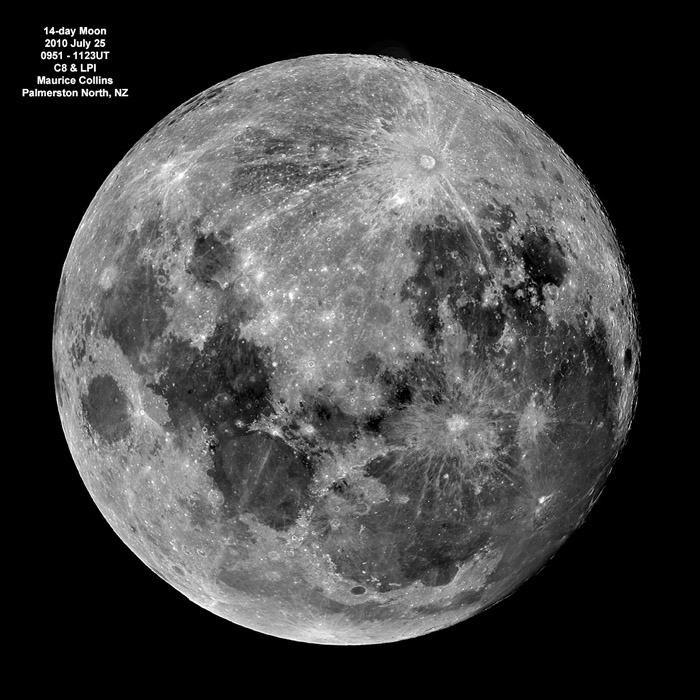Difference between revisions of "July 27, 2010"
(Created page with "__NOTOC__ =Darkness At Noon= <!-- ws:start:WikiTextHeadingRule:1:<h1> --> <!-- ws:start:WikiTextLocalImageRule:16:<img src="/file/view/LPOD-July27-10.jpg/154...") |
|||
| Line 6: | Line 6: | ||
<em>south up image (as seen down-under) by [mailto:mauricejscollins@hotmail.com Maurice Collins], New Zealand</em><br /> | <em>south up image (as seen down-under) by [mailto:mauricejscollins@hotmail.com Maurice Collins], New Zealand</em><br /> | ||
<br /> | <br /> | ||
| − | Northern Hemisphere summer is a tough time for LPOD because the Moon is low and clouds seem to be everywhere, so few images are submitted. But deep in the south, Maurice confirms what the almanac says: its full Moon time. I love full Moons because there is the chance to see familiar features in a new (overhead) light. One of the always surprising observations is how much variation there is across the maria. Some bits, like the eastern edges of Serenitatis and much of Tranquillitatis are fairly dark, but many areas are lighter, due to mineral composition and ray lightening. Most of Frigoris is a flat gray, like Lacus Somniorum, north of Posidonius. Something strange in this image is the dark area south of Mare Nectaris that doesn't look unlike some maria. This well-defined patch is between Tycho and the twin headlights near Stevinus. It looks much darker here than on many other full Moon shots such as this [mailto:tychocrater@yahoo.com Chuck Wood]</em><br /> | + | Northern Hemisphere summer is a tough time for LPOD because the Moon is low and clouds seem to be everywhere, so few images are submitted. But deep in the south, Maurice confirms what the almanac says: its full Moon time. I love full Moons because there is the chance to see familiar features in a new (overhead) light. One of the always surprising observations is how much variation there is across the maria. Some bits, like the eastern edges of Serenitatis and much of Tranquillitatis are fairly dark, but many areas are lighter, due to mineral composition and ray lightening. Most of Frigoris is a flat gray, like Lacus Somniorum, north of Posidonius. Something strange in this image is the dark area south of Mare Nectaris that doesn't look unlike some maria. This well-defined patch is between Tycho and the twin headlights near Stevinus. It looks much darker here than on many other full Moon shots such as this [http://www.lpod.org/coppermine/displayimage.php?pid=3237&fullsize=1 one]. I don't think there is an overlooked [http://lpod.armoredpenguin.com/wiki/March+15%2C+2010 cryptomaria] in the southern highlands, but this image and its processing - which I have added various enhancements to - does clearly define an extensive area of darkness in the highlands. Part of the darkness could de due to the [http://lpod.armoredpenguin.com/wiki/April+7%2C+2010 plutons] that are revealed in some young crater ejecta here, but in general I don't think we fully know how to explain it.<br /> |
| + | <br /> | ||
| + | <em>[mailto:tychocrater@yahoo.com Chuck Wood]</em><br /> | ||
<em>Update: Mystery solved! See 4th item in [http://lpod.wikispaces.com/message/view/July+27%2C+2010/25856793 Comments]</em><br /> | <em>Update: Mystery solved! See 4th item in [http://lpod.wikispaces.com/message/view/July+27%2C+2010/25856793 Comments]</em><br /> | ||
<br /> | <br /> | ||
Revision as of 21:00, 1 January 2015
Darkness At Noon
south up image (as seen down-under) by Maurice Collins, New Zealand
Northern Hemisphere summer is a tough time for LPOD because the Moon is low and clouds seem to be everywhere, so few images are submitted. But deep in the south, Maurice confirms what the almanac says: its full Moon time. I love full Moons because there is the chance to see familiar features in a new (overhead) light. One of the always surprising observations is how much variation there is across the maria. Some bits, like the eastern edges of Serenitatis and much of Tranquillitatis are fairly dark, but many areas are lighter, due to mineral composition and ray lightening. Most of Frigoris is a flat gray, like Lacus Somniorum, north of Posidonius. Something strange in this image is the dark area south of Mare Nectaris that doesn't look unlike some maria. This well-defined patch is between Tycho and the twin headlights near Stevinus. It looks much darker here than on many other full Moon shots such as this one. I don't think there is an overlooked cryptomaria in the southern highlands, but this image and its processing - which I have added various enhancements to - does clearly define an extensive area of darkness in the highlands. Part of the darkness could de due to the plutons that are revealed in some young crater ejecta here, but in general I don't think we fully know how to explain it.
Chuck Wood
Update: Mystery solved! See 4th item in Comments
Related Links
Maurice's website
COMMENTS?
Click on this icon File:PostIcon.jpg at the upper right to post a comment.




